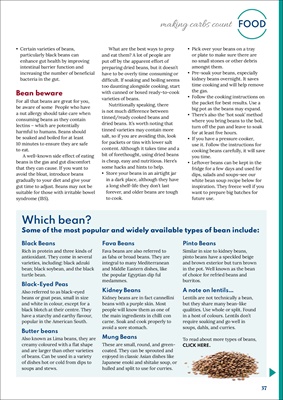
37
FOOD
making carbs count
• Certain varieties of beans,
particularly black beans can
enhance gut health by improving
intestinal barrier function and
increasing the number of beneficial
bacteria in the gut.
Bean beware
For all that beans are great for you,
be aware of some People who have
a nut allergy should take care when
consuming beans as they contain
lectins - which are potentially
harmful to humans. Beans should
be soaked and boiled for at least
10 minutes to ensure they are safe
to eat.
A well-known side effect of eating
beans is the gas and gut discomfort
that they can cause. If you want to
avoid the bloat, introduce beans
gradually to your diet and give your
gut time to adjust. Beans may not be
suitable for those with irritable bowel
syndrome (IBS).
What are the best ways to prep
and eat them? A lot of people are
put off by the apparent effort of
preparing dried beans, but it doesn't
have to be overly time consuming or
difficult. If soaking and boiling seems
too daunting alongside cooking, start
with canned or boxed ready-to-cook
varieties of beans.
Nutritionally speaking, there
is not much difference between
tinned/ready cooked beans and
dried beans. It's worth noting that
tinned varieties may contain more
salt, so if you are avoiding this, look
for packets or tins with lower salt
content. Although it takes time and a
bit of forethought, using dried beans
is cheap, easy and nutritious. Here's
some hacks and hints to help.
• Store your beans in an airtight jar
in a dark place, although they have
a long shelf-life they don't last
forever, and older beans are tough
to cook.
Which bean?
Some of the most popular and widely available types of bean include:
• Pick over your beans on a tray
or plate to make sure there are
no small stones or other debris
amongst them.
• Pre-soak your beans, especially
kidney beans overnight. It saves
time cooking and will help remove
the gas.
• Follow the cooking instructions on
the packet for best results. Use a
big pot as the beans may expand.
• There's also the 'hot soak' method
where you bring beans to the boil,
turn off the pan and leave to soak
for at least five hours.
• If you have a pressure cooker,
use it. Follow the instructions for
cooking beans carefully, it will save
you time.
• Leftover beans can be kept in the
fridge for a few days and used for
dips, salads and soups-see our
white bean soup recipe below for
inspiration. They freeze well if you
want to prepare big batches for
future use.
Black Beans
Rich in protein and three kinds of
antioxidant. They come in several
varieties, including: black adzuki
bean; black soybean, and the black
turtle bean.
Black-Eyed Peas
Also referred to as black-eyed
beans or goat peas, small in size
and white in colour, except for a
black blotch at their centre. They
have a starchy and earthy flavour,
popular in the American South.
Butter beans
Also known as Lima beans, they are
creamy coloured with a flat shape
and are larger than other varieties
of beans. Can be used in a variety
of dishes hot or cold from dips to
soups and stews.
Fava Beans
Fava beans are also referred to
as faba or broad beans. They are
integral to many Mediterranean
and Middle Eastern dishes, like
the popular Egyptian dip ful
medammes.
Kidney Beans
Kidney beans are in fact cannellini
beans with a purple skin. Most
people will know them as one of
the main ingredients in chilli con
carne. Soak and cook properly to
avoid a sore stomach.
Mung Beans
These are small, round, and greencoated.
They can be sprouted and
enjoyed in classic Asian dishes like
Japanese enoki and shitake soup, or
hulled and split to use for curries.
Pinto Beans
Similar in size to kidney beans,
pinto beans have a speckled beige
and brown exterior but turn brown
in the pot. Well known as the bean
of choice for refried beans and
burritos.
A note on lentils…
Lentils are not technically a bean,
but they share many bean-like
qualities. Use whole or split. Found
in a host of colours. Lentils don't
require soaking and go well in
soups, dahls, and curries.
To read about more types of beans,
CLICK HERE.